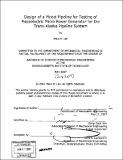Design of a model pipeline for testing of piezoelectric micro power generator for the Trans-Alaska Pipeline System
Author(s)
Lah, Mike M. (Mike Myoung)
DownloadFull printable version (1.410Mb)
Other Contributors
Massachusetts Institute of Technology. Dept. of Mechanical Engineering.
Advisor
Sang-Gook Kim.
Terms of use
Metadata
Show full item recordAbstract
In order to provide a reliable corrosion detection system for the Trans-Alaska Pipeline System (TAPS), a distributed wireless self-powered sensor array is needed to monitor the entire length of the pipeline at all times. Such a sensor faces two primary challenges: a method to provide power for the sensor, and a method to detect corrosion. This project has two goals: to build a model of the TAPS as a test bed for a piezoelectric micro power generator (PMPG), and to use the model to explore corrosion detection methods (perhaps by analyzing changes in the vibration spectrum), for use in the sensor array. To miniaturize the TAPS while maintaining its vibration spectrum, we will specify the dimensions of the model to have the same natural frequency, turbulent flow, and vortex induced vibrations as the actual pipeline. The model will serve as a test bed for various PMPG designs, and also serve as a starting point for exploring methods to detect corrosion in pipes. The primary vibration mode was found to be due to the natural frequency of the pipe, which was 20.2 Hz for the TAPS. Experimentally, we found the frequency to be in a range from 12-19 Hz. PMPG devices for use in the TAPS should be tuned to this frequency range.
Description
Thesis (S.B.)--Massachusetts Institute of Technology, Dept. of Mechanical Engineering, 2007. Includes bibliographical references (leaf 27).
Date issued
2007Department
Massachusetts Institute of Technology. Department of Mechanical EngineeringPublisher
Massachusetts Institute of Technology
Keywords
Mechanical Engineering.